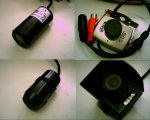You can use any cheap b/w camera (video type) that is always sensitive to IR, or any cheap (non-filtered) webcam too (only in pro models they add IR filters in the lens assembly, in the cheap models i never found them)
Also, i suggest you to use an assembly bw cam/monitor or webcam/pc, cause if any reflection hard enough hit directly the camera, the correspondent area of the CCD can die permanently ..... and, well, you can be unhappy, if you burn a $10 webcam, but i personally think you can be MUCH MORE unhappy if you burn some hunderd $ of digital camera

.....

EDIT: also, get some ND attenuation filter, cause the ccd usually get saturated very quickly, from laser focus points (after all, you're concentrating 3 W in a point of 1/10 or less of mm, the halo can be extremely large, especially on a camera) ..... maybe some 100:1 (or more, depend from the camera sensitivity) attenuation can permit you to see the focus point much better on the monitor, also with the camera close to the focus point ..... or also, substituting the diaphragm inside the lens assembly with a homemade one with a hole of 1/10 of mm or similar (a very thin needle can do that) can help if there's no attenuators enough dark ..... this require to disassemble and reassemble the lens assembly of the webcam, but works very good, and also increase a lot the field deepth of the camera, making the focus of the camera assembly much easy to do






